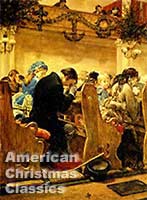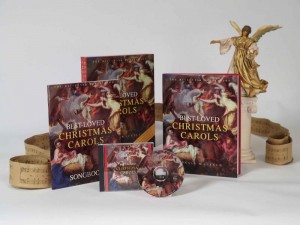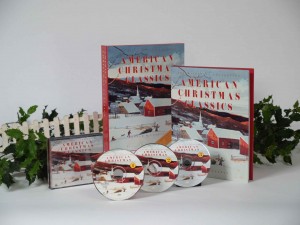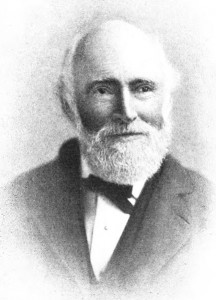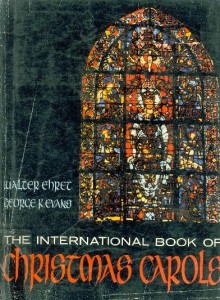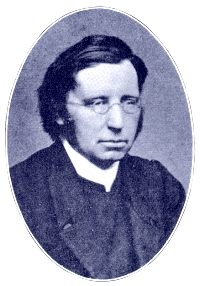Christmas Songs and Carols to Brighten the Holidays
Let us make this “a season to be jolly!” Despite our troubles, let us rekindle the fond memories of Christmas past for our parents, grandparents, and children. Let us touch the sentimental strings of carefree and youthful days that once consumed Baby Boomers and our military veterans.
Let us start with the idea of organizing some of our holiday festivities around the theme of singing carols and holiday songs. It doesn’t get better than hearing joyous Christmas songs while hauling in and trimming the Christmas tree.
Some familiar old-timers reminisce about the joy of Christmas songs and carols.
The late Andy Williams, a popular singer of the 1960s and 1970s, described celebrating the Christmas season in an interview with me several years ago. “It was such a great time,” Andy said, as he and his three older brothers used to go house to house singing carols and drinking eggnog in Wall Lake, Iowa.
“Those were the days when you knocked on a neighbor’s door and opened unlocked doors.” The talented singer who in later years starred at his Moon River Theater in Branson, Missouri, suggested it would be a nice thing to renew the tradition of caroling around the neighborhood, or one’s home town, “because it is such a wonderful thing to do.”
Della Reese, familiar to television viewers for her earthly role in the popular 1994-2003 program “Touched by an Angel,” wrote to me at the same time “I just love the way Christmas carols change the spirit and attitudes of us all.” An accomplished singer and ordained minister, in addition to her acting skills, she described “Silent Night” as a magnificent thought, and her favorite holiday tune as “Chestnuts Roasting on an Open Fire” sung by the mellifluous Nat “King” Cole. The irrepressible Della added, “In fact, I don’t really start my Christmas in earnest until I hear Nat sing “The Christmas Song.”
The late country and pop singer, Gene Pitney, enjoyed considerable success on both sides of the Atlantic through the mid-1960s with more than twenty Top 40 singles, including hits “Town Without Pity” and “Only Love Can Break a Heart.” In an e-mail Gene fondly recalled carving the turkey when his large family gathered for the holidays and the singing of Christmas carols. “I prefer religious carols,” he said, “that have not become jaded by commercial overuse. They represent the essential Christmas message.”
Take a cue from Andy, Della, and Gene. Start this holiday season with the idea of organizing your festivities around the theme of singing carols and holiday songs.
Celebrate with friends and family at home beside the fireplace or piano, or while trimming the Christmas tree, with traditional classics as “O Little Town of Bethlehem,” or “The Twelve Days of Christmas,” or singing such nostalgic holiday fare as “White Christmas,” “Have Yourself a Merry Little Christmas,” or “Rudolph the Red-Nosed Reindeer.”
Encourage friends to join in the singing of “Silent Night” and “We Wish You a Merry Christmas” in front of your neighbors’ city stoop or country home. Better yet, why not sing for our senior citizens at nursing home or an assisted care facilities, or at a food kitchen for the poor and homeless, or a military hospital for our aged veterans or wounded warriors? Rest assured your caroling there will be met with open hearts and ready smiles.
Or you might volunteer to take part in the local performance of Handel’s “Messiah” for other worthy causes, or support a local church by attending its vesper service where awe-inspiring Christmas motets and concertos may reverberate, and where the reverential carol-hymn “O Come, O Come, Emmanuel” soars to celestial heights on the wings of angels. This is truly music for the soul.
Though the custom of singing Christmas songs and carols in front of neighborhood homes may seem quaint and outdated, let us redouble our efforts, especially this year, to engage young and old alike in reviving a wonderful Christmas tradition that is never out of fashion.
Ron Clancy is a Christmas songs and carols historian, and the author of illustrated Christmas music gift collections at www.christmasclassics.com.
Christmas Eve 2013: Gratitude and Fisher House
Today is Christmas Eve, a much anticipated day on the Christian calendar that serves as a prelude to the birth of our savior Jesus Christ. For many of us it a day of evening worship at our parish church and a time to reflect on the meaningful story of Christmas so richly illuminated by the Gospel of St. Luke.
For me personally Christmas Eve floods me with childhood memories about going to midnight Mass and hearing a choir of nuns sing carols so beautifully that their notes seemed to spiral heavenward as though on the wings of angels. That warm and intoxicating experience has often been rekindled each Christmas Eve, especially today when I took time from doing last minute Christmas shopping to re-read several e-mails I recently received from Fisher House managers from across the country regarding the donations of Best-Loved Christmas Carols and American Christmas Classics, my two best-selling, highly illustrated Christmas music collections
Two of those e-mails were particularly poignant. Heather Frantz from the Fisher House of Pittsburgh wrote: I just wanted to let you know that we handed out your boxed collections to our guests this past Wednesday at our Christmas Party and they absolutely LOVED them!!!!!! We had several wives who were so touched by the gift that they teared up and they all opened them and couldn’t believe how amazing the book was and all of the stories and history behind the songs that they all love so much. Thank you so very much for providing such a joyous gift for our guests!!! Merry Christmas to you!
The second response came from Kristin Palmer, Fisher House of San Diego. I just wanted to follow up with you and let you know we received and have been distributing your Christmas collections to our families. I can tell you personally each family I have talked to is touched and awed by your generosity. The holiday season on a good day can be stressful enough, but to have to also deal with a loved one in a medical crisis compounds that stress. I gave the CDs to a mother whose 18 year old Marine is receiving cancer treatments. She was very moved, and thankful. Fortunately in her case she will be able to bring her son home for the holidays, and she said they would be listening to them and letting everyone they know about the generosity of the Fisher House and those that support it. For the rest of the families that will have to remain here for the holidays, at least they will have a little Christmas spirit and know someone was thinking of them during the holidays. Again, thank you and God bless!
The sentiments conveyed by Fisher House military families are similar to the feelings I had when the Knights of Columbus, SKF Industries, Villanova University students, and others annually feted us at St. John’s Orphanage in Philadelphia during the Christmas holidays. I fondly remember, along with hundreds of other orphan boys, the warm afterglow of being a starry-eyed recipient of carefully wrapped Christmas presents that were more precious than gold.
To hear that the joy of my Christmas days of yore has been replicated and found expression in the hearts of Fisher House military families truly humbles me. As it should for one who has benefited much from the Christmas spirit.
Merry Christmas!
Not too Late! Great Christmas Gifts for Military Families
It’s not too late! Please RT about Christmas Classics Ltd. support of the Fisher House Foundation this Christmas season. PRESS RELEASE
A great provider of free housing and comfort for military families in need of special medical care, the reputable foundation will benefit from the sale proceeds of Christmas Classics Ltd.’s two highly acclaimed Christmas music box collections, Best-Loved Christmas Carols and American Christmas Classics.
In addition, these premier collections are being donated to thirty-three Fisher Houses located across the country.
With the purchase today of Christmas Classics prized collections, described by customers and media alike as “great gifts,” you will make this Christmas season truly memorable, not only for your family and friends, but also for many of our military families who have suffered so much and yet have asked so little.
Merry Christmas!
Ronald M. Clancy
www.christmasclassics.com
Christmas Music Collections to Bring Cheer to Fisher Houses
Before the recent government shutdown occurred, author Ron Clancy of Christmas Classics Ltd. decided to support the Fisher House Foundation. A great provider of free housing and comfort for military families in need of medical care, the reputable foundation will benefit from the sale proceeds of Christmas Classics Ltd.’s two lavishly illustrated Christmas music collections (see FISHER HOUSE: How Others Are Giving).
In addition Ron has agreed to donate Best-Loved Christmas Carols and American Christmas Classics, his company’s premier boxed collections, to Fisher Houses located across the country.
To help bring special joy to Fisher House military families, Ron (@xmasmusicman) asks his Twitter followers to pass on the word about Christmas Classics Ltd. exceptional collections. The purchase of these ideal Christmas gifts for family and friends will help the Fisher House Foundation and its corollary Fisher Houses in the following ways:
1) 25% of sale proceeds will be donated to the Fisher House Foundation;
2) Christmas Classics Ltd. exquisite boxed collections will be donated to Fisher Houses across the country.
Please act today. Buy Christmas Classics Ltd. richly illustrated Best-Loved Christmas Carols and American Christmas Classics collections for your family and friends. Your purchase will go a long way to make this Christmas a truly memorable experience for those who have served our country so well and yet ask so little.
Today’s Video: The Story behind THE LITTLE DRUMMER BOY
Christmas Classics PERSON OF THE DAY: William J. Kirkpatrick
On this day in 1921, William J. Kirkpatrick died in Philadelphia. The son of a school teacher and musician, he was responsible for writing one of the more familiar arrangements for Away in a Manger.
Born in Duncannon, Pennsylvania, Kirkpatrick went to Philadelphia to learn music and carpentry. His ambition was to be a violinist, which was hampered as he plied his trade as a carpenter. At the age of thirty-four he began to devote more time to sacred music after joining the Wharton Street Methodist Episcopal Church in Philadelphia. As a member of the Harmonia and Handel and Haydn Sacred Music Societies, Kirkpatrick gained more exposure to the principal choral works of great composers. After the death of his first wife in 1878, he finally gave up his trade and dedicated his life solely to sacred music and composition, as well as being involved with the publication of forty plus hymnals.
Kirkpatrick’s tune for Away in a Manger, commonly known as The Cradle Song, is most used in England. The Cradle Song was first written in 1895 for the musical Around the World with Christmas. In the United States the tune most heard for Away in a Manger is associated with James Ramsey Murray (see my March 11, 2011 blog).
The anonymous lyrics for Away in a Manger likely were written by a member of the German Lutheran colony in Pennsylvania during the late 19th century. The words for the first two stanzas may have first appeared in 1885 in the Little Children’s Book for Schools and Families, a publication of the Evangelical Lutheran Church in North America. It is possible, however, that they first appeared in the May 1884 edition of The Myrtle, a Universalist Publishing House Boston publication, as Luther’s Cradle Hymn to commemorate the 400th anniversary of the birth of Martin Luther, the great German religious reformer. By the 1940s it was proven conclusively that the original lullaby tune had actually been composed by James Ramsey Murray, supposedly the same person who perpetrated the myth of Luther’s Cradle Hymn. Murray’s lullaby was included in an 1887 Cincinnati collection called Dainty Songs for Lads and Lasses.
Although many modern hymnals attribute the lyrics of the third stanza to John T. McFarland, a member of the American Lutheran Board of Sunday Schools, it is believed he had merely made reference to it. Instead, the third stanza, which first appeared in an 1892 Louisville, Kentucky, Lutheran Church collection titled Gabriel’s Vineyard Songs, was probably the contribution of another anonymous author. This lyrical addition strengthens the inherent tenderness of this renowned American carol hymn.
Three years later Kirkpatrick wrote the tune The Cradle Song for the musical Around the World with Christmas. Again, it is that tune that serves as Kirkpatrick’s arrangement for Away in a Manger.
Pennsylvania Germans and Moravians, besides being credited as the source for the anonymous lyrics of Away in a Manger, were unique in other aspects of Christmas. They celebrated the humble beginnings of the Christ Child by employing a Christmas decoration called a putz (from the German word “putzen” meaning “to adorn”), for the manger scene. The Moravians, furthermore, may even have played Away in a Manger in their trombone choirs that were known to perform from church belfries in Bethlehem, Nazareth, and other Pennsylvania towns with Moravian congregations.
Bethlehem, the site of the first Moravian church built in eastern Pennsylvania, was so named on Christmas Eve in 1742 when construction of the church was completed. That special night settlers sang in one room of the new structure while cows mooed in the other half, which served as a stable. The scene so moved the congregation, reminding them of events surrounding the birth of the Christ Child in another small town eighteen hundred years earlier, that they christened their settlement Bethlehem.
Christmas Classics PERSON OF THE DAY: William Chatterton Dix
On this day in 1898, William Chatterton Dix died in Cheddar, Somerset, England. He was bequeathed the middle name of Chatterton in honor of Thomas Chatterton, a poet whose biography was penned by Dix’s father. For a better part of his professional life Dix was a marine insurance agency manager, yet he is best known as the Christmas carol composer of the English carols What Child Is This? and As with Gladness Men of Old.
The insurance executive always nurtured a great love for poetry and hymns. His interest in both was accentuated at the age of twenty-nine when a near fatal illness and severe depression confined him to bed for months. It was also during this period when Dix wrote most of the forty hymns credited to him, including his most popular carol What Child Is This?
The lyrics for What Child Is This? were initially part of a six-stanza poem titled The Manger Throne. Dix later took three of the poem’s stanzas and adapted them to the popular 16th-century tune of Greensleeves. In 1871 both text and tune, the latter arranged by John Stainer, were published in Bramley & Stainer’s Christmas Carols, New and Old, a widely circulated compilation.
The beautiful folk melody of Greensleeves dates from Elizabethan times, perhaps even earlier, and reputedly it had less respectable lyrics sung to it in several lyrical settings. One of the earliest references to it was in 1580, and it was twice mentioned in Shakespeare’s comedy play, The Merry Wives of Windsor. In the 1642 New Christmas Carols black-letter edition, a variant tune of Greensleeves was used in the carol The Old Year Now Away Is Fled. Strains of the melody were also heard in John Gay’s 1728 satirical ballad opera, The Beggar’s Opera.
The providence of history is such that Greensleeves might be much lesser known if not for a strange illness that befell William Chatterton Dix. His effort to string religious pearls from his lengthy The Manger Throne, and the sometimes less respectable Greensleeves tune, ultimately prove successful with the issuance of What Child Is This? Since its 1871 publication, the beloved carol has been sustained by repeated publication and acclaim for its reverential treatment of the Nativity theme.
Christmas Classics PERSON OF THE DAY: John Sullivan Dwight
On this date in 1893, John Sullivan Dwight died in Boston. He was one of the more compelling figures from Harvard University who were Christmas carol composers or translators. They included among others, Edmund Hamilton Sears (It Came upon the Midnight Clear), Henry Wadsworth Longfellow (I Heard the Bells on Christmas Day), and Rev. Phillips Brooks (O Little Town of Bethlehem). Dwight’s contribution was providing the English translation for O Holy Night after the French carol Cantique de Noël.
After graduating from Harvard Divinity School, John Sullivan Dwight served as a Unitarian minister in Northampton, Massachusetts. But his stay there was short-lived. He had to leave the ministry because he became deathly ill when he had to deliver sermons to his congregation. After leaving the ministry he became a recluse and then sojourned to the socialistic Brook Farm community, of which he was one of its founders. For five years there he lived a transcendental life teaching classical languages and music. Life on the commune also meant time for farming, cutting wood, cultivating trees, and other chores.
Eventually he returned to Boston and devoted himself to literature where he became America’s first influential classical music critic writing for Dwight’s Journal of Music. For several years it was the only musical journal in the country.
Dwight also cultivated an interest in European carol tunes, particularly the French carol Cantique de Noël (a.k.a. Minuit Chrétiens). A carol with an intriguing history, it became much disliked by French church authorities even though it had originally been well received by them and the church faithful. This turnabout led to criticism about the carol’s perceived lack of musical taste and because it did not possess the “spirit of religion.” But the repudiation of the carol may have been due to Placide Cappeau, the carol lyricist, and his socialist leanings and later renunciation of Christianity; not to mention the fact that Adolphe Adam, the composer of the carol melody, was Jewish.
Thirteen years after Dwight’s death the carol had the distinction of being the first ever heard on the radio. On Christmas Eve in 1906 ships at sea heard O Holy Night being played on a violin.
- John Sullivan Dwight
Christmas Classics PERSON OF THE DAY: George K. Evans
On this day in 1917, George K. Evans was born in Arkansas. He is most noted as a translator and co-author of the highly respected The International Book of Christmas Carols published by Prentice-Hall in 1963 and reprinted in 1980 by S. Greene Press.
Evans was responsible, along with colleague Walter Ehret, for including in The International Book of Christmas Carols many carols theretofore never published in English collections, especially Slavic, Scandinavian, and Spanish carols. Evans himself provided the notes and translations for most of the carols, as well as for the popular German carol O Tannenbaum. In addition he wrote a fine seven page introduction to the book.
Fifteen years ago I spoke with the retired co-author about The International Book of Christmas Carols. He was quite proud of his contributions, and rightfully so I told him, but expressed disappointment that the book wasn’t more aggressively marketed. When I hinted that most carol books generally do not have large print runs, Evans ever the gentleman concurred. When I further commented that I thought his oeuvre d’ hors was one of the finest 20th century carol collections, he was greatly pleased for the attention.
George K. Evans died at his home in North Hollywood, California in 2003. He will always be remembered and honored here as a significant contributor to the international Christmas music repertoire.
Christmas Classics PERSON OF THE DAY: John Francis Wade
On this day in 1786, John Francis Wade died in Douai, France. He may be best known as the author of the reverential carol-hymn Adeste Fidelis (O Come All Ye Faithful). A Catholic laymen, Wade was forced to leave England for Duoai, France during the 1745 Jacobean rebellion because of continued persecution of Catholics.
Duoai was a medieval fortress town with a English college that was founded to combat the errors associated with the Reformation. English Catholics were welcomed there since the reign of Elizabeth I. The college curriculum was religious in scope, especially suited for the education of Catholic clergy, and for which the preservation of Catholicism in England was a prime objective. It also was an ideal haven for Wade since he taught music for children and copied plainchant (Gregorian chant) and hymn manuscripts for private use.
But Wade’s miniature masterpiece Adeste Fideles was composed sometime between 1740 and 1743. The Latin lyrics were published in 1760 in Evening Offices of the Church, and the melody and lyrics were printed together in An Essay on the Church Plain Chant (London, 1782).
In 1852 the Rev. Frederick Oakeley, an English clergyman who became a convert to the Roman Catholic Church, saw his English translation O Come All Ye Faithful of Wade’s hymn published, although he had translated the Latin text eleven years earlier. A William Thomas Brooke may have also had a hand translating some of the hymns verses.
Adeste Fideles has also been referred to as The Portuguese Hymn, because it was believed for a time to have been first sung by the famous choir of the Portuguese Chapel in London. This would not have been an unlikely scenario, as Wade was known to have corresponded with prominent Catholic musicians of the foreign embassy chapels there, including Thomas Arne, the highly respected English composer.
John Francis Wade is believed to have died in Duoai. His obituary read: Mr. John Francis Wade, a Layman, aged 75, with whose beautiful Manuscript Books our Chapels as well as private Families abound, in writing which, and teaching the Latin and Church Song he chiefly spent.
To which it should be added: Amen!
Christmas Classics PERSON OF THE DAY: Rev. John Mason Neale
On this day in 1866, the Rev. John Mason Neale died. A humble and scholarly Anglican priest, his reputation largely rests with his research and translations of ancient Greek and Latin religious texts, tasks that must have come easily to him since he was proficient in twenty-one different languages. The contributions of Neale to the revitalization of ancient and medieval church hymns and his deft translations of them cannot be underestimated. The brilliant scholar was known to have lamented the Reformation’s neglect of the rich history of hymnody, despite the movement’s praiseworthy restoration of worship and song to the language of the common people.
The Rev. Neale was also a well-respected composer of Christmas carols and hymns, some of which were delivered as a result of translating centuries-old hymns and songs, including those of a secular strain.
Three of those carols have grown quite popular since the publication of his 1853 collection Neale’s Carols for Christmastide. The most sacred was the carol hymn Veni, Emmanuel (O Come, O Come Emmanuel) based upon the Latin great O Antiphons of Advent whose seven verses are believed to have been composed by monastery monks who sang one verse per day at Vespers, the late afternoon or early evening canonical hour of prayer, for seven straight days prior to Christmas Eve.
Good Christian Men, Rejoice, the second carol, was Neale’s loose English translation of one of Germany’s best-loved carols, In Dulci Jubilo. Neale found the melody of this medieval Latin-German carol in Piae Cantiones, the famous 1582 Swedish book of carols that also produced the tune for Good King Wenceslas, the third familiar carol. For the latter, Neale was looking for a good role model for children. He found it in King Wenceslas of Bohemia who was known to be a just and merciful king and having considerable compassion for the poor and sick.
It could be said that King Wenceslas was also a role model for Neale himself since he, too, led an exemplary life by dedicating his life to the less fortunate. The hymn composer had a penchant for caring for the lowliest on society’s scale, and his Christian deeds set him apart from other clerics holding more lofty positions in the Anglican Church.
Such was Neale’s station in life that his own bishop, imagining Neale of Roman Catholic leanings, prohibited him from performing any ministerial duties and relegated him to a seemingly less desirable post. Thus, in 1846 Neale was made warden of Sackville College, a position he held for the rest of his life. Sackville College, however, was actually an almshouse, a charitable residence for the poor and aged. Twelve years later the humbly intrepid, and often frail and sickly, Neale founded the Sisterhood of St. Margaret, a group dedicated to the poor, needy, and suffering. For this charitable effort he was accused of a return to nuns, again earning him the enmity of Church authorities that thought he was converting to the Roman Catholic faith. Neale’s ministry later established an orphanage, a school for girls, and a home for unwed mothers, the latter forced to close due to church and local opposition. In a nutshell, Neale’s dedication to serving the poor and indigent was on a level with that of his work with sacred texts and hymns. Each pursuit was performed tirelessly, with dignity, and for the higher good.
Emmanuel, meaning “God with us,” is a splendid title for a carol hymn. It must have held special significance to Rev. Neale as he worked among the poor. The title reaffirms the religious concept of Christ’s birth as God Incarnate dwelling among men and announcing to them his mission here on earth. In the world of the ancient Hebrew, the choice of name was made judiciously, as the name Emmanuel must have been for Neale. For the scholarly Anglican priest, the name radiated in bold light and demonstrated, coincidentally, his own essential character and purpose as a man.
Today the Rev. Neale lays in peace at St. Swithun churchyard in East Grinstead, England, close to Sackville College where he abundantly served so well those who had so little.
